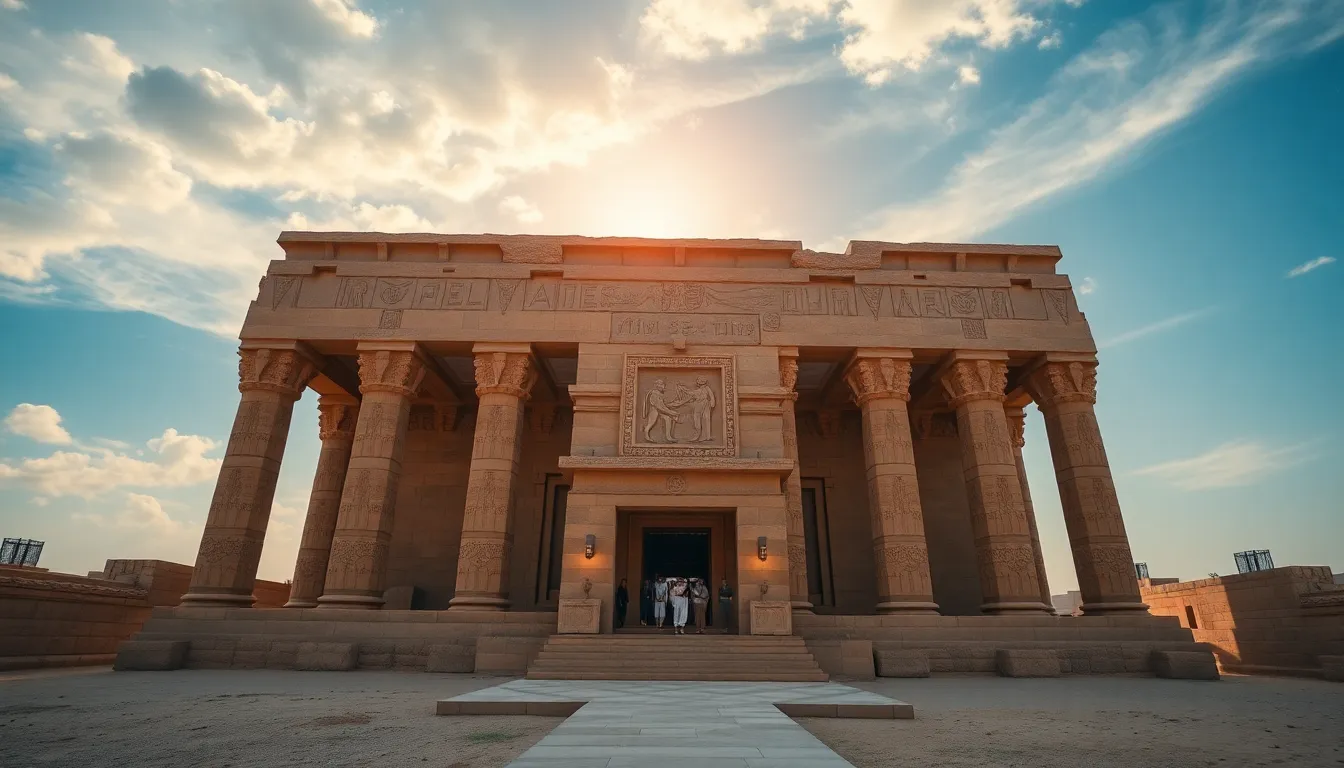Exploring the Divine: The Architecture of Egyptian Temples
I. Introduction
Ancient Egyptian culture is renowned for its monumental architecture and intricate religious practices, with temples standing as the most significant edifices in this civilization. Temples served not only as places of worship but also as vital centers of community life, economy, and political power. Their architectural grandeur reflects the Egyptians’ deep reverence for their deities and the afterlife.
This article aims to explore the architectural features and spiritual significance of Egyptian temples, shedding light on their evolution, design, and enduring legacy in understanding ancient Egyptian civilization.
II. Historical Context of Egyptian Temples
The construction of temples in ancient Egypt can be traced back to the Early Dynastic Period (c. 3100–2686 BCE), evolving through centuries of architectural innovation until the Ptolemaic Period (305–30 BCE).
A. Evolution of temple construction
Initially, temples were simple structures made of mudbrick, serving as shrines for local deities. As the civilization progressed, especially during the Middle Kingdom (c. 2055–1650 BCE) and the New Kingdom (c. 1550–1070 BCE), temples became more elaborate and monumental. The use of stone, expansive courtyards, and monumental gateways became prevalent.
B. Key historical events
- The unification of Upper and Lower Egypt led to the establishment of state-sponsored religious practices, prompting the construction of grand temples.
- The reigns of powerful pharaohs, like Ramses II, resulted in the creation of iconic temples that celebrated divine kingship.
- The influence of foreign cultures during the Ptolemaic Period brought new architectural styles and religious practices, merging Greek and Egyptian traditions.
III. Religious Significance of Temples
Temples were central to ancient Egyptian religion, serving as the primary sites for worship and rituals dedicated to the gods. They were believed to be the earthly homes of the deities, where mortals could interact with the divine.
A. Role of temples in worship
Egyptians practiced a variety of rituals within temple walls, including daily offerings, festivals, and sacred ceremonies. The high priest held significant authority, acting as the intermediary between the people and the gods.
B. Connection between realms
Temples symbolized the connection between the divine and the earthly realm. They were designed to facilitate this interaction, with specific areas reserved for the gods and others for the public. The sanctuaries often housed the cult statue of the deity, which was believed to be animated by the god’s presence during rituals.
IV. Architectural Features of Egyptian Temples
The design of Egyptian temples is characterized by a series of distinct architectural elements that reflect their spiritual significance.
A. Layout and design
A typical temple complex included:
- Forecourt: The open area leading to the entrance, often adorned with large columns.
- Hypostyle Hall: A grand hall filled with columns, serving as a transition between the outer and inner sanctums.
- Sanctuary: The most sacred space, housing the deity’s cult statue.
B. Use of columns, obelisks, and statues
Columns in temples were often elaborately decorated with carvings and hieroglyphs. Obelisks, towering stone monuments, were typically placed at the entrance, symbolizing the sun god Ra. Statues of gods and pharaohs adorned temple interiors, further emphasizing the divine presence.
V. Notable Examples of Egyptian Temples
Several temples stand out as remarkable examples of ancient Egyptian architecture:
A. The Temple of Karnak
As one of the largest religious complexes in the world, the Temple of Karnak was dedicated to the god Amun. It features a vast array of temples, chapels, and pylons, exemplifying the grandeur of ancient Egyptian architecture.
B. The Temple of Luxor
This temple is known for its stunning alignment with the Karnak Temple and its intricate carvings that depict the reign of Pharaoh Amenhotep III. It served both religious and political purposes.
C. Other significant temples
- Abu Simbel: Known for its colossal statues of Ramses II, this temple complex was built to commemorate the pharaoh’s victories.
- Temple of Hatshepsut: A mortuary temple dedicated to the female pharaoh, featuring terraces and impressive colonnades.
VI. Symbolism in Temple Architecture
The architecture of Egyptian temples is rich with symbolism, reflecting the beliefs and values of ancient Egyptians.
A. Geometry and proportion
Ancient Egyptians employed precise geometry in temple design, believing that mathematical proportions could create harmony with the cosmos. This meticulous attention to design was indicative of their understanding of the universe.
B. Symbolic representations
Architectural details often included representations of gods, mythological scenes, and hieroglyphics that conveyed religious narratives and cultural identity. These elements served both decorative and didactic purposes.
VII. Preservation and Modern Understanding
Efforts to preserve Egypt’s ancient temples have been ongoing, with archaeological teams working to protect and restore these historical sites.
A. Archaeological preservation
Modern techniques, including documentation, restoration, and conservation, have played a crucial role in maintaining the integrity of ancient temples. Organizations and governments collaborate to ensure these sites endure for future generations.
B. Modern interpretations
Scholars and archaeologists continue to study temple architecture, shedding light on the beliefs and practices of ancient Egyptians. This research enhances our understanding of their sophisticated civilization and its impact on history.
VIII. Conclusion
In conclusion, the architecture of Egyptian temples plays a vital role in understanding the complexities of ancient Egyptian civilization. These magnificent structures not only served as places of worship but also as symbols of power, community, and divine connection.
The legacy of Egyptian temple architecture endures, inspiring awe and admiration in contemporary society as we continue to explore the depths of this remarkable culture.




